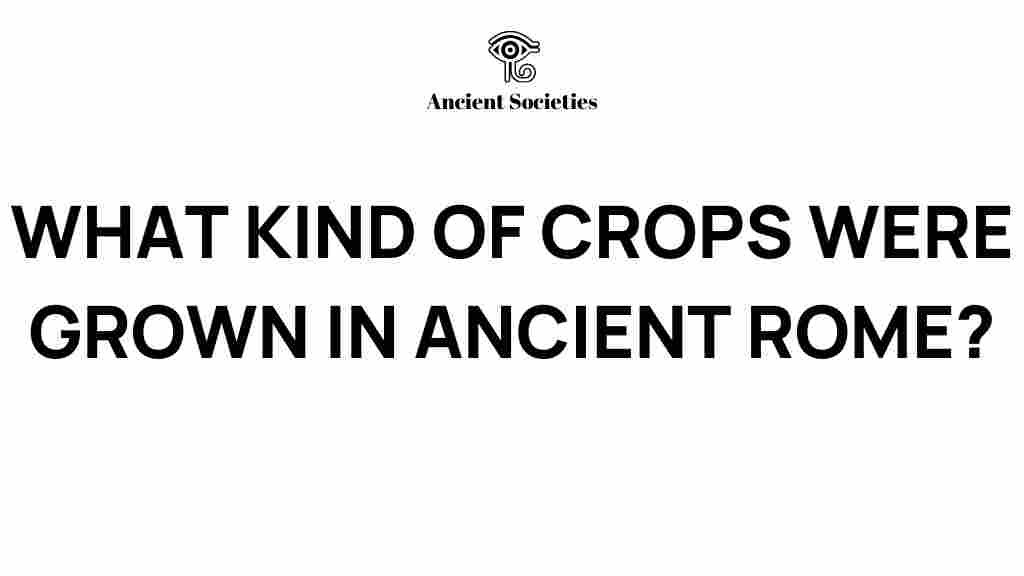Unearthing the Agricultural Secrets of Ancient Rome
The civilization of Ancient Rome is renowned for its advancements in various fields, from engineering to law. However, one of the cornerstones of its success was its agriculture. The farming practices of the Roman Empire played a crucial role in sustaining its vast population and fueling its economy. This article explores the intricate details of Ancient Roman agriculture, the types of crops cultivated, and how these practices shaped the history of the Roman civilization.
The Foundation of Roman Agriculture
Agriculture in Ancient Rome was not just a means of food production; it was a way of life. The Roman economy was heavily reliant on farming, which provided sustenance for families and the military. The agricultural landscape of the Roman Empire was diverse, encompassing a variety of crops and farming techniques.
Types of Crops in Ancient Rome
The Romans cultivated a wide range of crops, ensuring a steady supply of food. Key crops included:
- Grains: Wheat and barley were staple crops, essential for making bread, which was a primary food source.
- Legumes: Beans and lentils provided protein and were commonly used in Roman diets.
- Fruits: Figs, grapes, and apples were widely grown, with grapes also being used for wine production.
- Vegetables: Onions, garlic, and cabbage were among the vegetables cultivated in Roman gardens.
- Olives: Olive trees thrived in the Mediterranean climate, leading to the production of oil, a vital commodity.
These crops formed the backbone of Roman sustenance, supporting both the civilian population and the legions.
Farming Techniques of the Roman Empire
Roman farmers employed various techniques that enhanced productivity and efficiency:
- Crop Rotation: The practice of rotating different crops helped maintain soil fertility and reduce pests.
- Terracing: In hilly areas, terracing was used to create flat plots for farming, maximizing land use.
- Irrigation: The Romans developed sophisticated irrigation systems, channeling water from rivers and aqueducts to their fields.
- Use of Tools: Plows and sickles were commonly used, improving the efficiency of planting and harvesting.
These techniques not only boosted food production but also contributed to the economy of the Roman Empire.
The Role of Agriculture in the Roman Economy
The economy of Ancient Rome was intricately linked to agriculture. The surplus production of crops allowed for trade and commerce. Key aspects of this relationship included:
- Trade: Surplus crops were traded with other regions, fostering economic relations within the empire.
- Taxation: Agricultural produce was often taxed, providing revenue for the state.
- Employment: Farming provided livelihoods for a significant portion of the population, from landowners to laborers.
The economic stability provided by agriculture allowed the Roman Empire to expand and thrive for centuries.
Challenges Faced by Roman Agriculture
Despite its successes, Roman agriculture faced several challenges:
- Climate Variability: Changes in weather patterns could lead to droughts or floods, impacting crop yields.
- Pests and Diseases: Crops were susceptible to pests, which could devastate harvests.
- Land Degradation: Over-farming and poor land management practices led to soil depletion in some areas.
Farmers had to adapt to these challenges to ensure continued food production and sustain their communities.
Food Production and Roman Society
The food production system in Ancient Rome was essential for societal structure. The distribution of food influenced social hierarchies and political stability:
- Feeding the Military: Agriculture was vital for providing food to Roman legions stationed throughout the empire.
- Public Grain Doles: The government distributed grain to the poor, which helped maintain social order.
- Banquets and Feasts: Agriculture influenced social customs, including extravagant feasts for the elite.
Through these practices, agriculture was intrinsically linked to the fabric of Roman life.
Conclusion: The Legacy of Roman Agriculture
The agricultural practices of Ancient Rome laid the foundation for modern farming techniques and played a pivotal role in the development of Western civilization. The crops cultivated and the methods employed by Roman farmers have influenced agricultural practices throughout history. Understanding the intricacies of Ancient Roman agriculture not only sheds light on the economy and sustenance of the Roman Empire but also highlights the importance of agriculture in the growth and sustainability of civilizations.
For more insights into the history and impact of agriculture in Ancient Rome, visit this resource. If you have any questions or want to explore more about Roman farming practices, feel free to check out this informative link.
This article is in the category History and created by AncientSocieties Team
